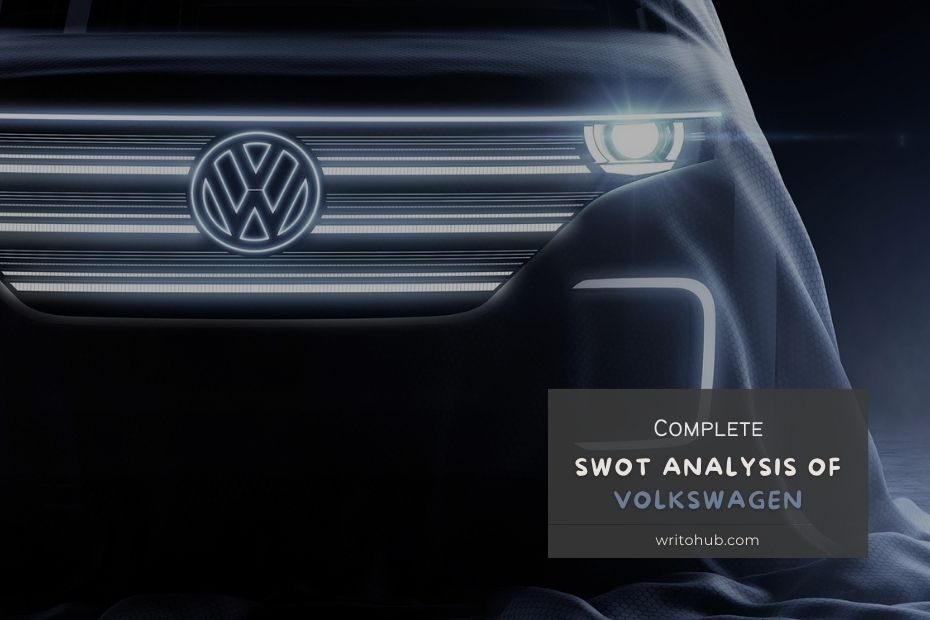The SWOT Analysis of Volkswagen tells the SWOT (Strengths, Weaknesses, Opportunities, and Threats) of the German automobile manufacturer – Volkswagen!
Volkswagen (VW), an automotive manufacturer, has been a prominent player in the global automotive market.
A comprehensive SWOT analysis of Volkswagen reveals its strengths, weaknesses, opportunities, and threats, offering insights into its strategic position in the dynamic automotive industry.
Marketing Mix – Click here to read the Marketing Mix of Volkswagen
Strengths in the SWOT Analysis of Volkswagen
- Strong Brand Portfolio: Volkswagen has a diverse brand portfolio, including Volkswagen, Audi, Porsche, and more, catering to various market segments.
- Global Presence: VW has a robust international presence, with manufacturing and sales operations in numerous countries, allowing it to access a wide range of markets.
- Engineering Excellence: Volkswagen is known for its engineering expertise, producing high-quality vehicles with a focus on performance and safety.
- Electric Vehicle Initiative: VW is investing heavily in electric vehicles (EVs) and plans to launch a variety of electric models, capitalizing on the growing demand for sustainable mobility.
- Innovation and Technology: Volkswagen is committed to innovation, integrating advanced technologies such as autonomous driving features and connectivity into its vehicles.
Weaknesses in the SWOT Analysis of Volkswagen
- Emissions Scandals: VW has faced significant reputational damage due to emissions scandals, which have resulted in fines and legal issues.
- Costly EV Transition: Transitioning to electric vehicles involves substantial investments in technology and infrastructure, which can impact short-term profitability.
- High Operating Costs: Volkswagen’s size and global presence come with high operating and administrative costs.
- Market Share Competition: Volkswagen competes with other well-established automakers, each striving to offer unique features and driving experiences.
- Dependence on Gasoline and Diesel: While VW is making strides in EVs, it remains dependent on gasoline and diesel vehicles, which may face regulatory challenges.
Opportunities in the SWOT Analysis of Volkswagen
- Electric and Autonomous Vehicles: Expanding the EV lineup and advancing autonomous driving technology can position VW as a leader in the future of mobility.
- Global Expansion: Exploring emerging markets and increasing presence in regions with growing demand for vehicles can boost sales.
- Digital Transformation: Enhancing digital connectivity, infotainment systems, and AI-driven features can attract tech-savvy consumers.
- Sustainability Initiatives: Focusing on sustainability practices, such as reducing emissions and incorporating renewable materials, aligns with evolving consumer preferences.
- Mobility Services: Venturing into mobility services like ride-sharing and car-sharing can create new revenue streams.
Threats in the SWOT Analysis of Volkswagen
- Intense Competition: VW faces fierce competition from established automakers, electric vehicle manufacturers, and tech companies entering the automotive sector.
- Economic Volatility: Economic downturns can impact vehicle sales as consumer spending on discretionary items decreases.
- Regulatory Changes: Evolving emissions regulations and safety standards can impact VW’s ability to produce vehicles with specific technologies.
- Supply Chain Disruptions: Disruptions in the supply chain, such as semiconductor shortages, can affect production and delivery times.
- Cybersecurity Risks: As vehicles become more connected, the threat of cybersecurity breaches and data privacy concerns could impact customer trust.
Conclusion
Volkswagen’s SWOT analysis underscores its position as a respected global automotive manufacturer, leveraging strengths to address weaknesses, seize opportunities, and mitigate threats.
The company’s ability to innovate, adapt to changing market dynamics, and lead in sustainable and advanced automotive technologies will determine its continued success in the competitive automotive industry.
